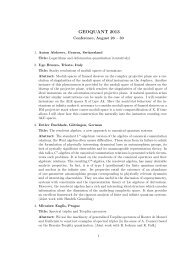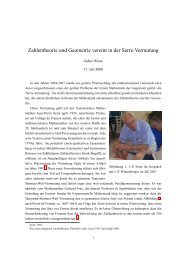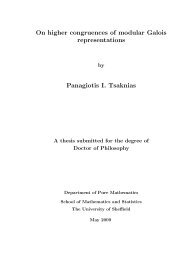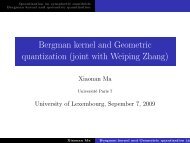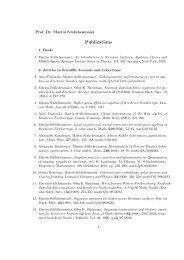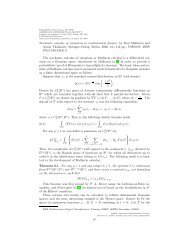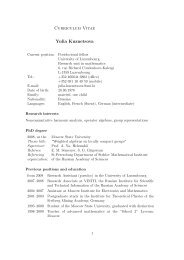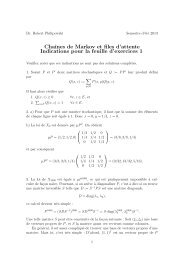THE 50th INTERNATIONAL MATHEMATICAL OLYMPIAD
THE 50th INTERNATIONAL MATHEMATICAL OLYMPIAD
THE 50th INTERNATIONAL MATHEMATICAL OLYMPIAD
You also want an ePaper? Increase the reach of your titles
YUMPU automatically turns print PDFs into web optimized ePapers that Google loves.
programme and the various human weaknesses (most notably bringing a protractor into the examination<br />
room, but more about this Geodreieck-Skandal, as UNK7 eloquently put it, later), which contestants are<br />
supposedly prone to fall prey to by Chief Invigilator and Chief Organiser Dierk Schleicher (wearing a unique<br />
double-sided badge in fetching blue and brown), rounded the day off. Dark yellow print on beige background<br />
is not readily decipherable. The Belgian team arrived much later in the evening, owing to a train engine<br />
failure or such-like, on which LUX5, somewhat characteristically, made ample comments. I have rarely seen<br />
Belgian deputy leader Philippe Niederkorn (BEL8) so agitated. Come to think of it, he seemed nearly as<br />
exasperated as when he commented on the quite disastrous results on the geometry questions in the two<br />
team selection tests.<br />
Tuesday, 14th July – The venue for this year’s opening ceremony appeared to be an industrial unit con-<br />
verted into a fashionable concert hall. The logistics of access to sanitary installations proved inadequate,<br />
and the fact that there was but a single set of toilets proved a serious drawback. Though an organiser<br />
was present to cordon off access to the toilets for either leaders or students, this person had clearly not<br />
anticipated the possibility of some leaders still being inside the toilets when students were already allowed<br />
access. On the cultural side, the opening ceremony boasted a dubious break-dance performance (yielding<br />
unwelcome flashbacks to the screeching girlie-band at the IMO 2007) and a finger-calculating performance<br />
by Albrecht Beutelsbacher, which was slightly less of a success. A photographer who was definitively not<br />
prone to vertigo managed to squeeze all the contestants into a single photograph, having realised that the<br />
one and only way to capture the attention of such a crowd was to provide sufficient evidence of imminent<br />
bloodshed by standing on a narrow rail some five meters above the ground. Catering in form of dubious<br />
packed lunches illustrated proverbial German efficiency seriously backfiring. We learnt later, much to our<br />
amusement, that some leaders had not been able to resist the temptation of a packed lunch, so that, when<br />
the contestants’ cohort attacked the terrified employees of the catering company, there was a serious shortage<br />
of lunch packets. In the afternoon, after we had waited for one hour and a half at the wrong spot, we found<br />
the photographer who made the team photographs. Upon return from a city tour paired with dinner in<br />
a very good restaurant, we had our pre-contest briefing with our guide, during which we learnt that not<br />
only protractors, but also set squares were considered personae non gratae in the contest room. It seems an<br />
attractive prospect to forbid the use of pencils during the contest. At least, this would considerably shorten<br />
the coordination period. LUX5 was angered by the flooding which the Australian contestant with whom he<br />
and LUX2 were sharing a bathroom had caused when he had taken a shower. LUX5 declared his intention<br />
of lecturing that poor Australian bloke on the subtleties of using a shower, that is telling him to close the<br />
door.<br />
Wednesday, 15th July – The first contest day started some ten minutes late, for many contestants were<br />
still queuing up in front of the insufficient sanitary facilities when the contest should already have started.<br />
The attempt of Chief Inviligator Dierk Schleicher to emulate IMOAB chair Jószef Pelikán, the epitome of<br />
multilingualism, who habitually delivers part of his opening address in the language of the host country, was<br />
an utter failure, for the French instructions were barely intelligible and those in Russian (another official<br />
language of the IMO) caused much roaring laughter among East European contestants. An embarrassing<br />
grammatical mistake on the verso of the answer paper definitively discredited the translator. The problems<br />
of the first day were, in this order, number theory, geometry, and algebra 4 . The setting of the geometry<br />
problem lacked an Oxford comma and we later learnt that the first problem was originally formulated in an<br />
obfuscated combinatorialish way. It was about members of a society giving each other presents according to<br />
a certain rule. The problem then asked to prove that it was impossible that someone was given a present of<br />
4 The problems of the first day of the Fiftieth International Mathematical Olympiad were:<br />
Problem 1. Letn be a positive integer and let a1, a2, a3, . . . , ak, where k ≥ 2, be positive integers in the set {1; 2; . . . ; n} such<br />
that n divides ai ai+1 − 1 <br />
for i = 1, . . . , k − 1. Prove that n does not divide ak a1 − 1 .<br />
Problem 2. Let ABC be a triangle with circumcentre O. The points P and Q are interior points of the sides [CA] and [AB],<br />
respectively. Let K, L, M be the midpoints of the segments [BP ], [CQ], and [P Q], respectively, and let Γ be the circle passing<br />
through K, L, and M. Suppose that the line P Q is tangent to the circle Γ. Prove that OP = OQ.<br />
Problem 3. Suppose that s1, s2, s3, . . . is a strictly increasing sequence of positive integers such that the subsequences<br />
ss1 , ss2 , ss3 , . . . and ss1+1, ss2+1, ss3+1, . . . are both arithmetic progressions. Prove that the sequence s1, s2, s3, . . . is itself an<br />
arithmetic progression.



